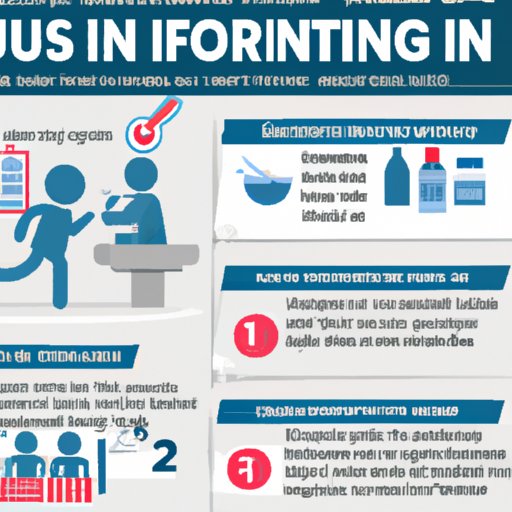Introduction
The flu, or influenza, is a virus that affects the respiratory system and can cause severe illness and even death. It is highly contagious, meaning it spreads easily from person to person, usually through coughing, sneezing, or contact with surfaces such as door handles or keyboards. Knowing when you are no longer contagious with the flu is important in order to protect yourself and others from getting sick.

Exploring the Duration of Flu Contagiousness
So how long are you contagious with the flu? The maximum contagious period is generally considered to be five days after symptoms appear. However, this can vary depending on a number of factors, including age and overall health. For example, a study published in The Lancet Infectious Diseases found that adults aged 18-64 were most infectious one day before symptoms appeared and for three days afterwards, while those aged 65 and over were most infectious two days before symptoms appeared and for four days afterwards.
Knowing When You Can Safely Return to Work After Having the Flu
If you have the flu, it is recommended that you stay home until your fever has been gone for 24 hours without the use of medication. This means that if your fever goes away but then returns within 24 hours, you should still stay home until the fever has been gone for 24 hours without medication. If you return to work too soon, you risk spreading the virus to your coworkers, which could lead to an outbreak in the workplace.
If you do return to work earlier than recommended, it is important to take precautions to reduce the risk of spreading the virus. This includes washing your hands often, covering your mouth and nose when coughing or sneezing, avoiding touching your face, and disinfecting any surfaces you touch.

What You Should Know About How Long the Flu Is Contagious
The flu is caused by a virus, so its symptoms may vary from person to person. Common symptoms include fever, chills, body aches, sore throat, cough, runny nose, headache, fatigue, and loss of appetite. Symptoms usually last two to seven days, although some people may experience more severe symptoms that can last up to two weeks.
Understanding the Timeline of Flu Contagiousness
The timeline of flu contagiousness begins with the incubation period, which is the time between exposure to the virus and the onset of symptoms. This period can last anywhere from one to four days. After symptoms appear, the person is typically contagious for five days, although the exact duration may vary depending on age and other factors.
It is also important to note that a person may be contagious before symptoms appear. This is known as the pre-symptomatic period, and it can last one to two days. During this time, the person may not know they have the virus, so taking precautions to prevent the spread of infection is important.

Tips for Reducing Flu Contagiousness and Protecting Others
The best way to reduce your risk of getting the flu and spreading it to others is to get the flu vaccine every year. Vaccination is especially important for those at higher risk of serious complications, such as young children and people with weakened immune systems.
In addition to vaccination, there are other steps you can take to reduce your risk of getting and spreading the flu. These include practicing good hygiene, such as washing your hands often and avoiding touching your face; avoiding close contact with those who are sick; and staying home when you are sick.
Conclusion
The flu is a highly contagious virus that can cause severe illness and even death. Knowing when you are no longer contagious with the flu is important in order to protect yourself and others. The maximum contagious period is generally five days after symptoms appear, although this can vary depending on age and health. It is also important to note that a person may be contagious before symptoms appear. To reduce the risk of getting and spreading the flu, it is important to practice good hygiene, get the flu vaccine every year, avoid contact with those who are sick, and stay home when you are sick.
By understanding the timeline of flu contagiousness, you can better protect yourself and others from getting sick. Following these tips can help ensure that you stay healthy and safe during the flu season.
(Note: Is this article not meeting your expectations? Do you have knowledge or insights to share? Unlock new opportunities and expand your reach by joining our authors team. Click Registration to join us and share your expertise with our readers.)
